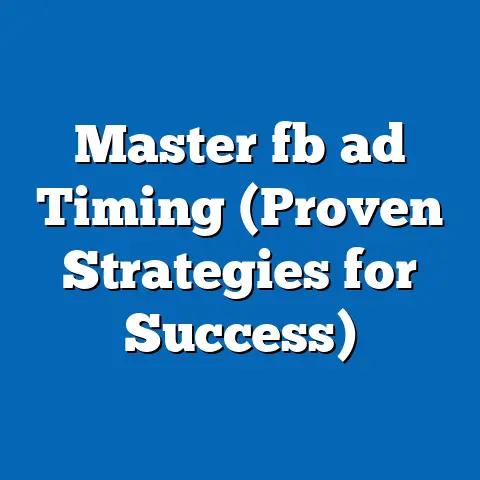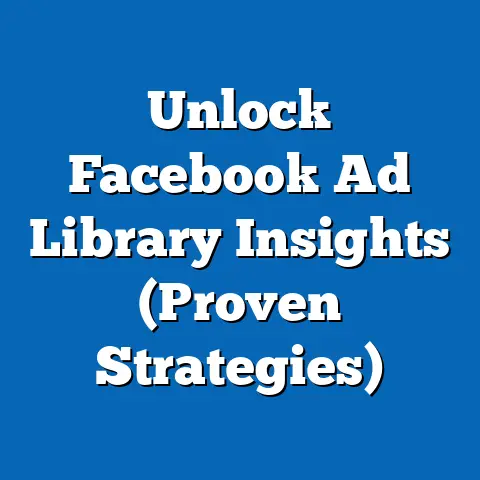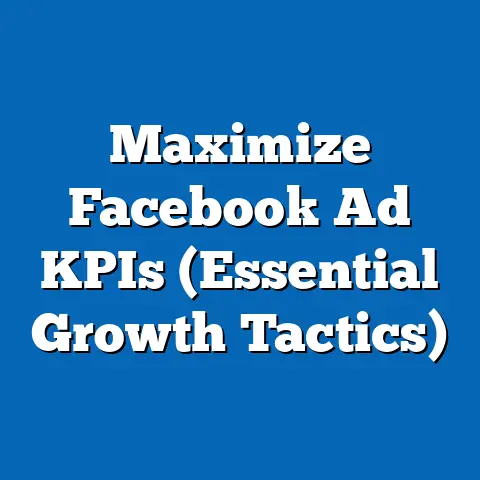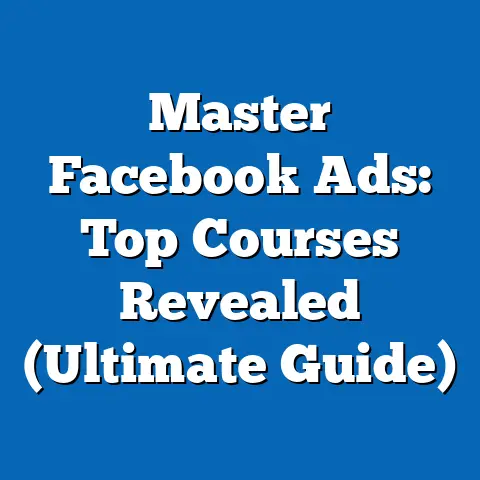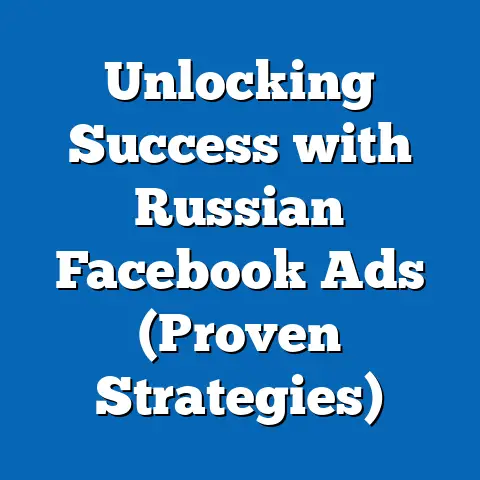Boost Restaurant Sales with Winning Facebook Ads (Pro Tips)
Remember the last time you savored a delightful meal at your favorite restaurant? The ambiance, the company, the perfectly cooked dish – it’s a memory etched in your mind. What if you could recreate that magic and attract more diners to your establishment using the power of Facebook ads?
In today’s digital age, Facebook advertising has become an indispensable tool for restaurants looking to connect with their local communities and drive foot traffic. With billions of active users, Facebook provides an unparalleled opportunity to reach potential customers with targeted and engaging ads. The key, however, lies in understanding the nuances of the platform and crafting campaigns that resonate with your audience.
In this article, I’ll share actionable insights and pro tips that I’ve gleaned from years of experience working with restaurants, helping them harness the power of Facebook ads to boost their sales. Let’s dive in and discover how you can transform your Facebook presence into a revenue-generating machine.
Section 1: Understanding the Facebook Ads Landscape
The landscape of Facebook advertising has changed dramatically over the years. What used to be a relatively simple platform has evolved into a sophisticated ecosystem with a multitude of options and features. For restaurants, understanding this landscape is crucial for maximizing their advertising ROI.
The Growth and Importance of Facebook Ads in the Restaurant Industry
Facebook’s dominance in the social media world is undeniable. With billions of users logging in daily, it offers an unparalleled opportunity for businesses, including restaurants, to reach a vast and diverse audience.
But why is Facebook so important for restaurants specifically? The answer lies in its ability to target local audiences with precision. Think about it: people often search for restaurants near them, and Facebook’s geo-targeting capabilities allow you to put your restaurant right in front of potential customers who are actively looking for a place to eat.
I’ve seen firsthand how a well-executed Facebook ad campaign can transform a struggling restaurant into a thriving local hotspot. It’s not just about getting your name out there; it’s about attracting the right customers who are genuinely interested in what you have to offer.
Different Types of Facebook Ads and Their Unique Advantages
Facebook offers a variety of ad formats, each with its own unique strengths. Understanding these formats is key to creating campaigns that resonate with your target audience. Here’s a rundown of some of the most popular options:
- Image Ads: These are the simplest and most common type of Facebook ad. They consist of a single image, ad copy, and a call-to-action button. Image ads are great for showcasing your restaurant’s ambiance or highlighting a specific dish.
- Video Ads: Video ads are incredibly engaging and can be used to tell a story or showcase your restaurant’s personality. Consider creating a short video tour of your restaurant, featuring your staff, or highlighting customer testimonials.
- Carousel Ads: Carousel ads allow you to display multiple images or videos in a single ad. This format is perfect for showcasing different menu items, highlighting various aspects of your restaurant, or telling a story in a sequential manner.
- Collection Ads: Collection ads are designed for mobile users and feature a large hero image or video, followed by a collection of related products. For restaurants, this could be used to showcase a selection of appetizers, entrees, or desserts.
- Instant Experience Ads: These are full-screen ads that open when someone clicks on your ad. They can include images, videos, carousels, and more, providing a rich and immersive experience for the user.
Each of these ad formats offers unique advantages, and the best choice for your restaurant will depend on your specific goals and target audience.
Statistics Showcasing the Effectiveness of Facebook Ads in Generating Restaurant Sales
Numbers don’t lie. Here are some compelling statistics that highlight the effectiveness of Facebook ads in driving restaurant sales:
- Local Awareness: Facebook ads are highly effective at driving local awareness. A study by Facebook found that 78% of local searches on mobile devices result in an offline purchase.
- Targeted Reach: Facebook allows you to target your ads based on demographics, interests, and behaviors. This means you can reach potential customers who are most likely to be interested in your restaurant.
- High Engagement: Facebook ads can generate high levels of engagement, including likes, comments, and shares. This engagement can help to build brand awareness and drive word-of-mouth marketing.
- Measurable Results: Facebook provides detailed analytics that allow you to track the performance of your ads and measure your ROI. This data can help you to optimize your campaigns and improve your results over time.
These statistics clearly demonstrate the potential of Facebook ads to drive restaurant sales. By understanding the platform and crafting effective campaigns, you can tap into this potential and transform your restaurant’s marketing efforts.
Takeaway: Facebook ads are a powerful tool for restaurants looking to reach local audiences and drive sales. Understanding the different ad formats and leveraging the platform’s targeting capabilities are key to creating successful campaigns.
Section 2: Setting Your Goals
Before you even think about creating your first ad, it’s crucial to define what you want to achieve. Setting clear, measurable goals is the foundation of any successful Facebook ad campaign. Without a clear destination in mind, you’re essentially driving blind.
The Importance of Setting Clear, Measurable Goals
Imagine you’re planning a road trip. You wouldn’t just hop in the car and start driving without knowing where you’re going, right? You’d have a destination in mind, a route planned, and maybe even some milestones along the way. The same principle applies to Facebook advertising.
Setting clear, measurable goals provides direction and focus for your campaigns. It helps you to:
- Define Your Target Audience: Knowing what you want to achieve helps you to identify the specific audience you need to reach.
- Craft Compelling Ad Creative: Clear goals inform the messaging and visuals you use in your ads.
- Measure Your Success: Measurable goals allow you to track your progress and determine whether your campaigns are working.
- Optimize Your Campaigns: By tracking your results, you can identify areas for improvement and optimize your campaigns for maximum ROI.
Examples of Common Goals for Restaurants
Here are some common goals that restaurants might set for their Facebook ad campaigns:
- Increasing Reservations: This is a straightforward goal that can be measured by tracking the number of reservations made through your website or by phone.
- Boosting Takeout Orders: If you offer takeout or delivery, you can use Facebook ads to drive more orders through your website or app.
- Promoting Special Events: Use Facebook ads to promote special events, such as live music, themed dinners, or holiday celebrations.
- Driving Foot Traffic: This goal can be measured by tracking the number of customers who visit your restaurant after seeing your ad.
- Building Brand Awareness: Use Facebook ads to increase awareness of your restaurant and build a positive brand image.
- Generating Leads: Collect leads from potential customers by offering a discount or special offer in exchange for their email address.
Aligning Ad Campaigns with Overall Business Objectives
It’s important to align your Facebook ad campaigns with your overall business objectives. For example, if your goal is to increase revenue, your ad campaigns should focus on driving sales. If your goal is to build brand awareness, your ad campaigns should focus on reaching a wider audience and creating a positive brand image.
I always advise my clients to think about the big picture. How does this ad campaign fit into your overall marketing strategy? How will it contribute to your long-term business goals? By aligning your ad campaigns with your business objectives, you can ensure that your marketing efforts are focused and effective.
Takeaway: Setting clear, measurable goals is the foundation of any successful Facebook ad campaign. Align your ad campaigns with your overall business objectives to ensure that your marketing efforts are focused and effective.
Section 3: Identifying Your Target Audience
Imagine you’re trying to sell vegan burgers to a group of meat-loving cowboys. It’s probably not going to be a very successful venture, right? The same principle applies to Facebook advertising. If you’re not targeting the right audience, your ads are going to fall flat.
The Significance of Understanding Your Audience
Understanding your audience is crucial for creating effective ads that resonate with them. It allows you to:
- Craft Compelling Ad Copy: Knowing your audience’s interests and needs allows you to write ad copy that speaks directly to them.
- Choose the Right Visuals: Understanding your audience’s preferences helps you to select visuals that will capture their attention.
- Target Your Ads Effectively: Knowing your audience’s demographics, interests, and behaviors allows you to target your ads to the people who are most likely to be interested in your restaurant.
- Maximize Your ROI: By targeting the right audience, you can ensure that your ad spend is focused on the people who are most likely to become customers.
Tips on How to Define Your Target Audience Using Facebook’s Audience Targeting Tools
Facebook offers a wealth of targeting options that allow you to reach a specific audience with your ads. Here are some tips on how to define your target audience using Facebook’s audience targeting tools:
- Demographics: Target your ads based on age, gender, location, education, and other demographic factors.
- Interests: Target your ads based on people’s interests, such as food, dining, cooking, or specific cuisines.
- Behaviors: Target your ads based on people’s behaviors, such as their purchasing habits, travel patterns, or online activity.
- Custom Audiences: Create custom audiences based on your existing customer data, such as email lists or website visitors.
- Lookalike Audiences: Create lookalike audiences based on your custom audiences. This allows you to reach new people who are similar to your existing customers.
I often encourage my clients to start with a broad audience and then narrow it down based on the data they collect. A/B testing different audiences is a great way to see what resonates best.
The Importance of Local Targeting for Restaurants
For restaurants, local targeting is absolutely essential. You want to reach people who are in your area and are likely to visit your restaurant. Facebook’s local targeting options allow you to target your ads based on:
- Location: Target your ads to people who live in or are visiting a specific city, state, or zip code.
- Radius Targeting: Target your ads to people who are within a certain radius of your restaurant.
- Address Targeting: Target your ads to people who live at or have recently visited a specific address.
When setting up your local targeting, consider the following factors:
- Your Restaurant’s Location: Make sure you’re targeting the area that’s within a reasonable driving distance of your restaurant.
- Your Target Audience: Consider the demographics and interests of people who live in your target area.
- Your Budget: Local targeting can be more expensive than broader targeting, so make sure you have a budget that can support it.
Takeaway: Understanding your target audience is crucial for creating effective Facebook ads. Use Facebook’s audience targeting tools to reach a specific audience with your ads, and don’t forget the importance of local targeting for restaurants.
Section 4: Crafting Compelling Ad Creative
You’ve got your goals set and your target audience defined. Now, it’s time to create some compelling ad creative that will grab their attention and entice them to visit your restaurant.
Tips for Creating Eye-Catching Visuals
Visuals are the first thing people see when they encounter your ad, so it’s essential to make them eye-catching and appealing. Here are some tips for creating visuals that will capture your audience’s attention:
- Use High-Quality Images: Use professional-quality images that are well-lit and in focus.
- Showcase Your Restaurant’s Ambiance: Use images that highlight the atmosphere and decor of your restaurant.
- Highlight Your Best Dishes: Use images that showcase your most popular or visually appealing dishes.
- Use Video Content: Video content is incredibly engaging and can be used to tell a story or showcase your restaurant’s personality.
- Use Bright Colors: Use bright colors that will stand out in the Facebook newsfeed.
I always tell my clients to think about what makes their restaurant unique and to showcase that in their visuals. What’s the vibe? What are you known for? Let that shine through.
The Importance of Writing Engaging Ad Copy
Your ad copy is just as important as your visuals. It’s what will persuade people to click on your ad and visit your restaurant. Here are some tips for writing engaging ad copy:
- Speak Directly to Your Target Audience: Use language that resonates with your target audience.
- Highlight the Benefits of Visiting Your Restaurant: Tell people what they will gain by visiting your restaurant, such as delicious food, a great atmosphere, or a memorable experience.
- Use a Strong Call-to-Action: Tell people what you want them to do, such as “Book a Table,” “Order Online,” or “Visit Our Website.”
- Keep It Concise: People are busy, so keep your ad copy short and to the point.
- Use Humor: If appropriate, use humor to make your ad more memorable.
Examples of Successful Ad Copy and Visuals from Real Restaurant Campaigns
Let’s take a look at some examples of successful ad copy and visuals from real restaurant campaigns:
- Example 1: A local Italian restaurant used a high-quality image of their signature pasta dish and wrote the following ad copy: “Craving authentic Italian? Come experience the taste of Italy right here in town. Book your table now and enjoy a complimentary glass of wine with your meal!”
- Example 2: A trendy burger joint used a video of their chefs preparing a juicy burger and wrote the following ad copy: “Get your burger fix! Our handcrafted burgers are made with fresh, local ingredients and are guaranteed to satisfy your cravings. Order online for takeout or delivery!”
- Example 3: A family-friendly restaurant used an image of a happy family enjoying a meal and wrote the following ad copy: “Looking for a place to celebrate a special occasion? Our family-friendly restaurant offers delicious food, a welcoming atmosphere, and something for everyone. Book your reservation today!”
These examples demonstrate the power of using high-quality visuals and engaging ad copy to capture your audience’s attention and drive them to your restaurant.
Takeaway: Crafting compelling ad creative is essential for attracting customers to your restaurant. Use eye-catching visuals and engaging ad copy to capture your audience’s attention and persuade them to visit your restaurant.
Section 5: Leveraging Facebook’s Ad Formats
As I mentioned earlier, Facebook offers a variety of ad formats, each with its own unique strengths. Let’s explore how restaurants can leverage these different formats to create effective campaigns.
Exploring Different Ad Formats for Restaurants
Here’s a deeper dive into some of the ad formats that are particularly well-suited for restaurants:
- Stories Ads: Facebook Stories are a popular way for people to share their daily experiences. Stories ads appear between organic stories and can be a great way to reach a younger audience. For restaurants, Stories ads can be used to showcase behind-the-scenes content, highlight daily specials, or promote upcoming events.
- Collection Ads: Collection ads are designed for mobile users and feature a large hero image or video, followed by a collection of related products. For restaurants, this could be used to showcase a selection of appetizers, entrees, or desserts. When a user clicks on a product in the collection, they are taken to a full-screen experience where they can learn more and make a purchase.
- Lead Ads: Lead ads are designed to collect leads from potential customers. They allow users to submit their contact information without leaving the Facebook app. For restaurants, lead ads can be used to collect email addresses for your mailing list or to gather information about customer preferences.
Specific Examples of Effective Ad Formats for Restaurants
Here are some specific examples of how restaurants can use different ad formats to achieve their goals:
- Increasing Reservations: Use a carousel ad to showcase different dishes and highlight the restaurant’s ambiance. Include a “Book a Table” button that links directly to your online reservation system.
- Boosting Takeout Orders: Use a video ad to showcase the preparation of a popular takeout dish. Include a “Order Online” button that links to your online ordering platform.
- Promoting Special Events: Use a Stories ad to promote an upcoming event, such as live music or a themed dinner. Include a “Learn More” button that links to your event page.
The Role of Video Content in Facebook Ads
Video content is incredibly engaging and can be a powerful tool for restaurants. Here are some ways to use video content in your Facebook ads:
- Showcase Your Restaurant’s Personality: Create a short video tour of your restaurant, featuring your staff, and highlighting the atmosphere.
- Highlight Customer Testimonials: Feature customer testimonials in your video ads to build trust and credibility.
- Showcase the Preparation of Your Dishes: Create videos that show the preparation of your most popular dishes.
- Promote Special Events: Use video to promote upcoming events and give people a taste of what they can expect.
Takeaway: Facebook offers a variety of ad formats that can be leveraged by restaurants to create effective campaigns. Consider using Stories ads, Collection ads, and Lead ads to reach your target audience and achieve your goals. Don’t underestimate the power of video content in your Facebook ads.
Section 6: Budgeting and Bidding Strategies
You’ve got your ad creative ready to go, but how much should you spend? And how should you bid for ad placements? These are crucial questions that can significantly impact the success of your Facebook ad campaigns.
Determining a Budget for Facebook Ads
Determining a budget for your Facebook ads can be tricky. It depends on a variety of factors, including your business goals, target audience, and competition. Here are some tips to help you determine an appropriate budget:
- Start Small: If you’re new to Facebook advertising, start with a small budget and gradually increase it as you see results.
- Set a Daily Budget: Facebook allows you to set a daily budget, which is the average amount you’re willing to spend per day.
- Consider Your Revenue Targets: Think about how much revenue you need to generate from your Facebook ads to make them worthwhile.
- Track Your ROI: Keep a close eye on your ROI and adjust your budget accordingly.
I often advise my clients to think of their Facebook ad budget as an investment, not an expense. It’s an investment in reaching new customers and driving sales.
Different Bidding Strategies
Facebook offers several different bidding strategies, each with its own advantages and disadvantages. Here are some of the most common options:
- Cost Per Click (CPC): With CPC bidding, you pay each time someone clicks on your ad. This is a good option if your goal is to drive traffic to your website or landing page.
- Cost Per Impression (CPM): With CPM bidding, you pay for every 1,000 impressions your ad receives. This is a good option if your goal is to build brand awareness.
- Cost Per Action (CPA): With CPA bidding, you pay only when someone takes a specific action, such as making a purchase or submitting a lead form. This is a good option if your goal is to generate leads or drive sales.
The best bidding strategy for your restaurant will depend on your specific goals and target audience.
Optimizing Ad Spend for Maximum ROI
Here are some tips on how to optimize your ad spend for maximum ROI:
- Target the Right Audience: Make sure you’re targeting the right audience with your ads. The more targeted your audience, the more likely they are to be interested in your restaurant.
- Use Compelling Ad Creative: Use high-quality visuals and engaging ad copy to capture your audience’s attention.
- A/B Test Your Ads: A/B test different ad creatives and targeting options to see what works best.
- Track Your Results: Keep a close eye on your results and adjust your campaigns accordingly.
- Use Retargeting: Retarget people who have previously visited your website or interacted with your Facebook page.
Takeaway: Determining a budget and choosing the right bidding strategy are crucial for maximizing your ROI. Start with a small budget and gradually increase it as you see results. Consider your revenue targets and track your ROI. Experiment with different bidding strategies and optimize your ad spend for maximum ROI.
Section 7: Tracking and Analyzing Performance
You’ve launched your Facebook ad campaigns, but the work doesn’t stop there. It’s essential to track and analyze your performance to see what’s working and what’s not.
The Importance of Tracking Ad Performance
Tracking your ad performance allows you to:
- Measure Your ROI: See how much revenue you’re generating from your Facebook ads.
- Identify Areas for Improvement: Identify areas where your campaigns are underperforming.
- Optimize Your Campaigns: Make adjustments to your campaigns to improve your results.
- Make Data-Driven Decisions: Base your decisions on data rather than gut feelings.
Key Performance Indicators (KPIs) to Monitor
Here are some key performance indicators (KPIs) that you should monitor:
- Click-Through Rate (CTR): The percentage of people who click on your ad after seeing it. A high CTR indicates that your ad is relevant and engaging.
- Conversion Rate: The percentage of people who take a desired action after clicking on your ad, such as making a reservation or placing an order. A high conversion rate indicates that your landing page or website is effective.
- Cost Per Click (CPC): The amount you pay each time someone clicks on your ad. A low CPC indicates that you’re targeting the right audience and using effective ad creative.
- Return on Ad Spend (ROAS): The amount of revenue you generate for every dollar you spend on advertising. A high ROAS indicates that your campaigns are profitable.
- Engagement Metrics: Track likes, comments, shares, and other engagement metrics to see how people are interacting with your ads.
Actionable Insights on How to Interpret Data
Here are some actionable insights on how to interpret your data:
- Low CTR: If your CTR is low, try using different visuals or ad copy.
- Low Conversion Rate: If your conversion rate is low, try improving your landing page or website.
- High CPC: If your CPC is high, try targeting a different audience or using different bidding strategies.
- Low ROAS: If your ROAS is low, try optimizing your campaigns for maximum ROI.
I always tell my clients to be patient and persistent. It takes time to optimize your campaigns and see results. Don’t be afraid to experiment and try new things.
Takeaway: Tracking and analyzing your ad performance is essential for optimizing your campaigns and maximizing your ROI. Monitor key performance indicators such as CTR, conversion rate, CPC, and ROAS. Use your data to identify areas for improvement and make data-driven decisions.
Section 8: Best Practices and Pro Tips
Now that we’ve covered the fundamentals, let’s dive into some best practices and pro tips that can help you take your Facebook ad campaigns to the next level.
Best Practices for Creating Successful Facebook Ad Campaigns
Here are some best practices for creating successful Facebook ad campaigns tailored to restaurants:
- Know Your Audience: Understand your target audience’s demographics, interests, and behaviors.
- Set Clear Goals: Define what you want to achieve with your campaigns.
- Use High-Quality Visuals: Use professional-quality images and videos that are visually appealing.
- Write Engaging Ad Copy: Use language that resonates with your target audience and highlights the benefits of visiting your restaurant.
- Choose the Right Ad Format: Select the ad format that’s best suited for your goals and target audience.
- Target Your Ads Effectively: Use Facebook’s targeting options to reach the people who are most likely to be interested in your restaurant.
- Set a Realistic Budget: Determine a budget that’s appropriate for your goals and target audience.
- Track Your Results: Monitor your KPIs and make adjustments to your campaigns as needed.
Pro Tips from Industry Experts
Here are some pro tips from industry experts:
- Use Retargeting: Retarget people who have previously visited your website or interacted with your Facebook page.
- Run A/B Tests: A/B test different ad creatives and targeting options to see what works best.
- Stay Up-to-Date on Facebook’s Ad Policies: Make sure you’re familiar with Facebook’s ad policies and that your ads comply with them.
- Use Facebook Pixel: Install the Facebook Pixel on your website to track conversions and retarget website visitors.
- Engage with Your Audience: Respond to comments and messages on your Facebook page to build relationships with your customers.
A/B Testing and Continuous Optimization
A/B testing is the process of comparing two versions of an ad to see which one performs better. This is a great way to optimize your campaigns and improve your results over time.
Here are some things you can A/B test:
- Visuals: Test different images and videos to see which ones resonate best with your audience.
- Ad Copy: Test different headlines, descriptions, and calls-to-action.
- Targeting Options: Test different demographics, interests, and behaviors.
- Bidding Strategies: Test different bidding strategies to see which one generates the best ROI.
Takeaway: Follow these best practices and pro tips to create successful Facebook ad campaigns for your restaurant. A/B testing and continuous optimization are essential for improving your results over time.
Section 9: Real-Life Success Stories
Let’s take a look at some real-life success stories of restaurants that have significantly increased sales through effective Facebook advertising.
Case Study 1: “The Cozy Corner Cafe”
The Cozy Corner Cafe is a small, family-owned restaurant that was struggling to attract new customers. They decided to try Facebook advertising and saw incredible results.
- Strategy: They used Facebook ads to target local residents with images of their delicious breakfast and lunch specials. They also ran ads promoting their weekend brunch menu.
- Results: Within three months, The Cozy Corner Cafe saw a 30% increase in sales. They also gained a large number of new followers on their Facebook page.
- Lessons Learned: The Cozy Corner Cafe’s success demonstrates the power of local targeting and using high-quality visuals.
Case Study 2: “Spice Route Indian Cuisine”
Spice Route Indian Cuisine is a popular Indian restaurant that wanted to increase their takeout orders. They used Facebook ads to target people who were interested in Indian food.
- Strategy: They created a video ad that showcased the preparation of their most popular takeout dishes. They also offered a discount for first-time takeout orders.
- Results: Spice Route Indian Cuisine saw a 40% increase in takeout orders within two months. They also gained a large number of new customers.
- Lessons Learned: Spice Route Indian Cuisine’s success demonstrates the power of video content and offering incentives to new customers.
Case Study 3: “The Gourmet Grill”
The Gourmet Grill is an upscale restaurant that wanted to promote their special events, such as wine tastings and live music nights.
- Strategy: They used Facebook ads to target people who were interested in wine and live music. They also created event pages on Facebook and promoted them with ads.
- Results: The Gourmet Grill saw a significant increase in attendance at their special events. They also gained a large number of new customers who were interested in their offerings.
- Lessons Learned: The Gourmet Grill’s success demonstrates the power of promoting special events on Facebook and targeting people who are interested in those events.
Takeaway: These real-life success stories demonstrate the potential of Facebook advertising to drive restaurant sales. By following the strategies outlined in this article, you can achieve similar results.
From understanding the Facebook ads landscape to setting your goals, identifying your target audience, crafting compelling ad creative, leveraging Facebook’s ad formats, budgeting and bidding strategies, tracking and analyzing performance, and following best practices, I’ve covered everything you need to know to create successful Facebook ad campaigns for your restaurant.
With the right strategies, Facebook ads can be a powerful tool for boosting your restaurant’s sales. Don’t be afraid to experiment and try new things. The key is to be patient, persistent, and data-driven.
So, what are you waiting for? Take action and implement the tips provided in this article to start seeing results. Your restaurant’s success is just a few clicks away!

